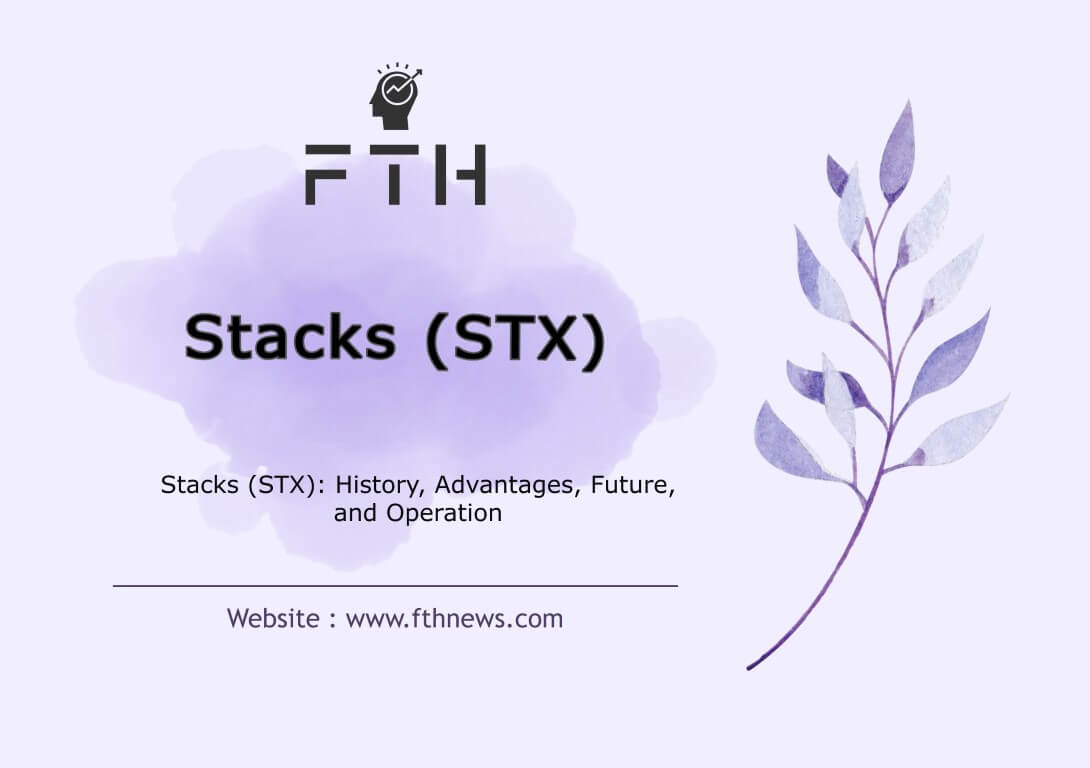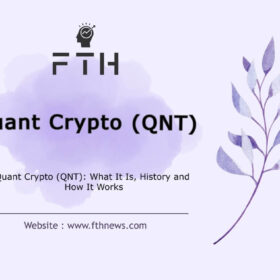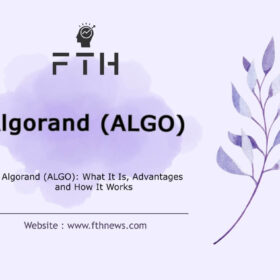
Stacks (STX): What It Is, Advantages and How It Works
In the rapidly evolving landscape of blockchain technology, Stacks, formerly known as Blockstack, emerges as a one-layer blockchain project with a unique mission — to seamlessly integrate smart contracts and decentralized programs into the Bitcoin network. This innovative project aims to bridge the gap between multiple crucial technologies without altering their core functionalities.
Understanding the Stacks Digital Currency Project (STX)
Stacks, represented by the symbol STX, utilizes Bitcoin as its foundational layer for recording information. By leveraging the security and stability inherent in the Bitcoin blockchain, Stacks ensures a robust environment for executing smart contracts and decentralized applications (DApps).
Proof of Transfer (POT) Mechanism
The Stacks network employs a Proof of Transfer (POT) mechanism, where the Bitcoin network acts as the final security layer for smart contracts executed on the Stacks blockchain. This unique connection facilitates the execution of transactions on the Stacks network, followed by their confirmation on the Bitcoin blockchain. Importantly, this dual-layer approach addresses scalability concerns within the Bitcoin network, offering a compelling solution.
Evolution from Blockstack to Stacks
Originally known as Blockstack, the platform underwent a rebranding in late 2020 to become Stacks. This change aimed to distinguish the open-source project from its parent company, Blockstack PBC. The transition marked a strategic move to emphasize the platform’s independence and commitment to providing an open and secure ecosystem for developers.
Clarity Programming Language: Ensuring Safety and Simplicity
At the heart of the Stacks network is the Clarity programming language, a compiler-free language designed for the secure execution of smart contracts. This language ensures that smart contracts are executed exactly as published to blockchain nodes, enhancing predictability and security. The simplicity of the Clarity language also aligns with the principles of the Algorand blockchain, where it is similarly employed.
Interconnected Networks: Stacks and Bitcoin
Despite being independent blockchain networks, Stacks and Bitcoin operate in tandem through a proof-of-transfer consensus mechanism. This mechanism enables the seamless transfer of new digital currencies and smart contracts from the Bitcoin network to the Stacks network, fostering interoperability between the two.
Regulatory Recognition and Stacks’ Milestones
A notable achievement for Stacks was obtaining a license from the United States Securities and Exchange Commission (SEC) in July 2019. This regulatory acknowledgment underscored the platform’s commitment to compliance and transparency, allowing it to successfully raise $28 million through coin sales.
The Purpose and Vision of Stacks (STX)
Stacks serves as a layer 1 blockchain network specifically crafted to introduce smart contracts and DApps to the Bitcoin network. The platform’s unique architecture allows the seamless transfer of these decentralized applications to Bitcoin without compromising its fundamental features. Stacks envisions a future where developers collaborate on open-source DApps, harnessing the security and ubiquity of the Bitcoin blockchain.
Objectives of the STX Digital Currency Platform
The STX digital currency platform, synonymous with Blockstack, outlines key objectives for designing DApps:
- User-Friendly DApps: Stacks aims to enhance the ease of use for decentralized applications, fostering a user-friendly environment for both developers and end-users.
- Scalability: Addressing the scalability challenge, Stacks envisions supporting millions of users concurrently accessing decentralized applications built on its platform.
- User Control and Identification: The platform prioritizes user control and identification within DApps running on the Stacks network, emphasizing security and privacy.
As Stacks continues to evolve, its commitment to innovation and integration with Bitcoin positions it as a trailblazer in the blockchain space, reshaping the landscape of decentralized applications and smart contracts.
Understanding the Stacks (STX) Network Mechanism
The Stacks network operates on the innovative Proof of Transfer (POX) mechanism, a distinct consensus algorithm that sets it apart from traditional proof-of-work (POW) and proof-of-stake (POS) mechanisms commonly seen in blockchain projects. This mechanism, a product of the evolution from Proof of Burn (POB), contributes to the network’s robustness and security.
Evolution from Proof of Burn to Proof of Transfer
Derived from the Proof of Burn (POB) mechanism, the POX mechanism addresses the environmental concerns associated with high energy consumption in POW while offering a unique approach to network security. In POB, coins staked by miners are burned and permanently removed from circulation. However, Stacks’ Proof of Transfer (POX) mechanism takes a different route — it transfers the newly mined digital currencies to other users within the ecosystem, contributing to a dynamic reward protocol.
Proof of Transfer (POX) vs. Proof of Burn (POB)
While both mechanisms share similarities, the key distinction lies in the fate of the staked coins. Unlike in POB, where the coins are irreversibly destroyed, POX ensures that the newly mined digital currencies find their way into the hands of other users in the Stacks ecosystem. This not only facilitates a rewarding protocol but also allows users to actively engage with two different blockchains simultaneously.
Integration with the Bitcoin Blockchain
Crucially, the Stacks network integrates with the Bitcoin blockchain, leveraging its robust security without relying on a traditional POW mechanism. This integration enables the creation of new blocks in the Stacks network concurrently with those in the Bitcoin network, fostering a seamless interconnectedness.
Miners and Stacks: The Dual Sections
The Stacks network comprises two integral sections: miners and stacks.
- Miners in the Stacks Network:
- With the creation of each new block in the Bitcoin network, a corresponding block is generated in the Stacks network.
- Miners in Stacks participate in a unique election process to choose a leader by sending Bitcoin to the Bitcoin network.
- A random selection mechanism, favoring miners who contribute larger amounts of Bitcoin, determines the leader for each round.
- The chosen leader then creates the new block in the Stacks blockchain, initiating the reward distribution for miners.
- Miners receive rewards, both from the network and transaction fees, based on a defined formula.
- 1000 STX coins per block for the first 4 years.
- 500 STX coins per block for the second 4 years.
- 250 STX coins per block for the third 4 years.
- 125 STX coins per block indefinitely after the completion of the third period.
- Halving in the Stacks network follows the Bitcoin model.
- Miners receive 40% of the network fee in STX coins for creating each new block, with the remaining 60% going to miners confirming the blocks.
- Rewards are contingent on building 100 blocks in the Bitcoin blockchain, with the actual distribution occurring 24 hours after this milestone.
As the Stacks network continues to evolve, its unique Proof of Transfer mechanism and seamless integration with the Bitcoin blockchain position it as a pioneering force in the blockchain space, addressing environmental concerns while ensuring security and scalability.
Stacks in the Stacks Network: Unveiling STX Token Stacking
Within the Stacks network, “stacks” refer to STX token stackers who actively participate in the network’s consensus mechanism. These individuals or entities, by staking or depositing their STX coins for approximately two weeks to complete a 10,000 block confirmation cycle on the Bitcoin network, are rewarded from the Bitcoin (BTC) network. Stacks also serve as nodes in the Stacks network, contributing to the recording of transaction information within their systems. Importantly, this network distinguishes itself by not implementing slashing or penalties for nodes, a departure from the punitive measures associated with traditional Proof of Stake (POS) mechanisms.
Ways to Stake STX Coins:
- Okcoin Exchange Staking:
- STX holders can stake a minimum of 50 coins on the Okcoin exchange, earning annual profits of approximately 10% and receiving rewards from the Bitcoin network.
- Decentralized Pools Staking:
- STX coin holders have the option to earn Bitcoin rewards by staking a minimum of 50 coins in various decentralized pools such as Xverse Pool, Friedgers Pool, Planbetter, and Staked. The specific type of pool chosen determines the nature of the rewards.
- Hiro Wallet Staking:
- Individuals holding more than 100,000 STX coins can choose to stake them in the dedicated wallet of the Stacks network, known as Hiro Wallet. This enables them to receive rewards directly from the Bitcoin network.
- Coinbase and Bitgo Exchange Staking:
- Large institutions and individuals holding substantial amounts of STX coins can opt to stake their coins on exchanges such as Coinbase and Bitgo. This allows them to receive profits directly from the Stacks network.
Staking Dynamics in the Stacks Network:
In this unique network, miners contribute BTC to mine STX coins, while STX token holders, through the process of storing or stacking their coins, receive Bitcoin as a reward. This symbiotic relationship between miners and STX holders reinforces the interconnected nature of the Stacks network, creating a dynamic ecosystem where participants are incentivized to actively engage in the network’s activities.
As the Stacks network continues to evolve, the flexibility and accessibility of its staking mechanisms make it an attractive proposition for a diverse range of stakeholders, fostering a decentralized and inclusive environment.
Services on the Stacks Network
- Pravica:
- An integrated communication program designed according to Web 3.0 standards, Pravica utilizes Blockchain Stacks technology to elevate user privacy and security.
- Ryder:
- A digital identity program within the internet space, Ryder relies on the Stacks network for its security infrastructure.
STX Coin: Digital Currency of Stacks
The STX digital currency is the native coin of the Stacks network, mined by participants leveraging the proof-of-transfer mechanism. This versatile coin plays a pivotal role in the Stacks ecosystem:
- Used for consensus within the Stacks network.
- Rewarded to miners for their contributions.
- Utilized to pay network fees.
- Stored by network nodes to receive rewards.
STX Coin Distribution:
- 29.2% sold in 2017.
- 8.9% sold in 2019.
- 2.4% distributed on Blockchain.com.
- 14.2% allocated to the Hiro fund.
- 7.4% stored in the development fund.
- 4.1% held by independent institutions.
- 6.6% released through software.
- 3.8% designated for academic research.
- 6.6% owned by Muneeb Ali, the founder.
- 7.9% held by the development team.
- 8% distributed among investors.
Stacks Network Roadmap: 2017 to the First Half of 2021
2017:
- $47.5 million in funding via coin purchases.
- Public alpha release of Blockstack Browser.
- Inaugural Blockstack Summit in Mountain View.
- Creation of the Signature Fund for decentralized applications.
- Establishment as a Public Benefit Corporation (PBC).
- Alpha developer platform launch.
- Stacks white paper publication.
- Completion of R&D phase with $4 million from the Union Square organization.
2018:
- Successful launch of Blockchain Stacks 1.0.
- Mining Pilot launch and basic applications on App.co.
- Establishment of New Internet Labs in Hong Kong.
- Stacks 1.0 testnet and wallet launch.
- Alpha version release of Android and IOS developers SDKs.
- Blockstack Berlin conference with Edward Snowden as keynote speaker.
- Gaia decentralized storage release with multiplex support.
2019:
- App Mining 1.0 growth from 27 to 350 programs.
- STX coin listing on Binance and Hashkey Pro.
- Hosting the 4th Annual Blockstack Summit.
- Partnership with Lambda School to teach Blockstack.
- SEC-qualified IPO and Asian strategic financing round.
- Blockstack 2.0 white paper update.
- Prototype virtual machine release.
- Commencement of R&D phase for Stacks 2.0.
The First Half of 2020:
- Increased decentralization and independent entities.
- STX 2.0 test network release.
- Formation of the independent STX Foundation.
- Creation of Wallet SDK for integration with STX wallet.
- User authentication with simplified UX.
- Proof-of-Transfer (PoX) Mining White Paper release.
- Last hard fork of the STAX 1.0 chain.
The Second Half of 2020:
- STX 2.0 mainnet launch.
- Creation of collections for shared user data.
- Android STX 2.0 wallet launch with ledger integration.
- Transparent programming language and developer resources.
- Community-Based App Mining 2.0 Proposals and Grants.
The First Half of 2021:
- Stacks 2.0 network launch.
- Transparent smart contract programming language on Stacks 2.0 mainnet.
- Commencement of stacking rewards for PoX consensus participation.
As STX continues its journey, these milestones underscore its commitment to innovation, decentralization, and community-driven development.
Strategic Collaborations in the Stacks Network:
The Stacks network has forged impactful collaborations with key industry players, companies, and investors, further cementing its position in the blockchain space. Let’s delve into these significant partnerships:
Okcoin Exchange:
One of the largest digital currency exchanges, Okcoin collaborates with the Stacks network as one of the STAX network pools, contributing to the network’s robustness and liquidity.
Coinbase:
A leading cryptocurrency exchange in the United States, Coinbase is a strategic partner in building one of the Stacks network pools. This collaboration strengthens the network’s presence and accessibility.
BitGo Exchange:
Based in California, BitGo exchange aligns with the Stacks network as one of the STAX network pools. This partnership emphasizes the network’s commitment to collaboration with prominent players in the crypto space.
Injective Protocol:
A decentralized network operating on the Ethereum network, Injective Protocol integrates with the Stacks network, enabling users to create permanent and futures contracts on the Bitcoin network. This collaboration extends the utility and reach of both platforms.
Chainlink Oracle:
Renowned as one of the largest oracles in the digital currency realm, Chainlink collaborates with Stax in the development of smart contracts within the Stacks network. This partnership empowers developers to utilize Chainlink data, enhancing the security of smart contracts through the Bitcoin blockchain.
Brink Protocol:
A protocol supporting developers with financial and educational resources to strengthen the Bitcoin network, Brink Protocol partners with the Stacks network for mutual development and growth.
Blockchain.com:
The collaboration between Blockchain.com and the STX network involves the airdrop distribution of STX coins in February 2018, fostering wider adoption and engagement within the crypto community.
USDC Stablecoin:
One of the largest stablecoins in the crypto market, USDC aims to build and make available the stablecoin of the STAX network. This collaboration underscores the commitment to stability and reliability within the Stacks ecosystem.
Blockdaemon:
As one of the largest independent blockchain infrastructure platforms, Blockdaemon connects institutions and developers in the sector to leading networks, contributing to the growth and scalability of the Stacks network.
Wrapped Network:
The Wrapped network, specializing in tokenizing major cryptocurrencies on various blockchain networks, is set to implement xBTC, the Bitcoin token, on the Stacks network. This collaboration expands the range of tokenized assets on the Stacks platform.
These strategic collaborations reflect the STX network’s commitment to fostering innovation, interoperability, and a vibrant ecosystem that benefits both developers and users within the blockchain space.
Founders of the Stacks Network:
The Stacks network, initially funded by prominent investment funds such as Y Combinator, Digital Currency, and Winklevoss Capital, was developed by the Blockstack PBC project in New York. This project, now operating under the name Hiro Systems PBC, was founded by Muneeb Ali and Ryan Shea. Let’s delve into the backgrounds of these two visionaries:
- Muneeb Ali:
- A computer science graduate with a master’s degree and doctorate, Muneeb Ali founded Stax in 2013 and currently serves as the CEO of Hiro Systems PBC. His leadership has been instrumental in shaping the Stacks network into a pioneering force in the blockchain space.
- Ryan Shea:
- The second founder of the Stacks project, Ryan Shea, brought his expertise as a software engineer to the initiative. His contributions have played a crucial role in the development and growth of the Stacks network.
History of the Blockstack Platform:
The roots of the Blockstack project trace back to 2013 when Muneeb Ali and Ryan Shea founded it. With the aim of addressing fundamental challenges in web and mobile applications, the project gained momentum. In 2014, Ali and Shea presented the project to Y Combinator, securing initial investments. Work on blockchain technology ensued, leading to the launch of the first version of Blockstacks in 2017. The project has since evolved, with Blockstack PBC becoming Hiro Systems PBC.
Where to Buy STX Cryptocurrency:
STX cryptocurrency, the native coin of the STX network, can be purchased on various centralized exchanges, including but not limited to Binance, Okcoin, Blockchain.com, Kocoin, Crypto.com, Upbit, OKEx, and FTX.
Choosing a Wallet for STX Coin:
For secure storage of STX coins, users can opt for reputable wallets such as Ledger and Trezor hardware wallets. Additionally, compatible software wallets include Math Wallet, Trust Wallet, Boom Wallet, Xverse, New Internet Labs, Neptune, Cerebro, D’CENT, and the official wallet Hiro.
Features of the Stacks Network:
The STX network boasts distinctive features that set it apart in the blockchain landscape:
- Predictability: Developers can use precise and clear language in programs and smart contracts, allowing them to predict the exact performance of their contracts.
- User-Determined Transaction Conditions: High security is ensured by enabling users to determine transaction conditions themselves.
- Smart Contract Distribution: Smart contracts are spread throughout the blockchain network, enhancing accessibility and functionality.
Advantages of Stacks Digital Currency:
The STX digital currency, underpinned by the STX network, offers numerous advantages, including:
- DeFi members enjoying the extensive possibilities of Bitcoin while executing smart contracts.
- Simultaneous earning of bitcoins for network participants.
- Offering rewards to STX token holders in Bitcoin, fostering engagement and participation.
Unique Aspects of Stax Digital Currency:
STX digital currency aims to augment the strengths of Bitcoin with additional functionality, all without the need to fork or alter the main blockchain. The Proof-of-Transfer consensus mechanism (POX) serves as the bridge to the Bitcoin blockchain. Miners, in this protocol, pay Bitcoin to mine blockchain cryptocurrency tokens, and users can receive bitcoins as rewards by saving STX tokens. This unique approach positions Stax as a novel and innovative player in the cryptocurrency space.
Security Measures of the Stacks Network
The security architecture of the STX network is robust, leveraging the Bitcoin blockchain as its foundational layer. The integration with Bitcoin, a Proof-of-Work (POW)-based blockchain, brings inherent security benefits, considering the vast network of miners and nodes employed to safeguard against attacks. Several aspects contribute to the high-security standards of the STX network:
- Bitcoin Blockchain Integration:
- Stacks digital currency relies on the Bitcoin blockchain as its main and primary layer. Bitcoin’s widespread adoption and utilization of Proof-of-Work consensus ensure a decentralized and secure foundation for the Stacks network.
- Proof of Transfer (PoX) Consensus Model:
- The Stacks network employs the Proof of Transfer (PoX) consensus model as its mining mechanism. In this innovative protocol, users mine STX tokens by transferring Bitcoin. The miner selected to mine the next block is determined based on the amount of Bitcoin sent. This unique approach enhances security by aligning incentives and maintaining a fair and transparent selection process.
- Mining Probability and Bitcoin Transfers:
- In the Proof of Transfer mechanism, the probability of a miner being selected to mine the next block is directly proportional to the amount of Bitcoin they transfer. This mechanism not only aligns economic incentives but also introduces an element of fairness, ensuring that miners with larger contributions have a commensurate chance of mining the next block.
By combining the security features of the Bitcoin blockchain with the innovative Proof of Transfer consensus model, the STX network establishes a resilient and secure environment for smart contracts and decentralized applications. The integration with Bitcoin not only bolsters security but also aligns the STX network with one of the most robust and widely adopted blockchain ecosystems in existence.
FAQ
Stacks (STX) is a cryptocurrency associated with the Stacks network, which is designed to enhance the functionality of the Bitcoin network by enabling smart contracts and decentralized applications (DApps). Stacks leverages the Bitcoin blockchain as its base layer, ensuring security and stability, while also offering unique features such as the Proof of Transfer consensus mechanism. In essence, Stacks facilitates the execution of smart contracts and DApps on the Bitcoin network without the need for major modifications to its blockchain.














